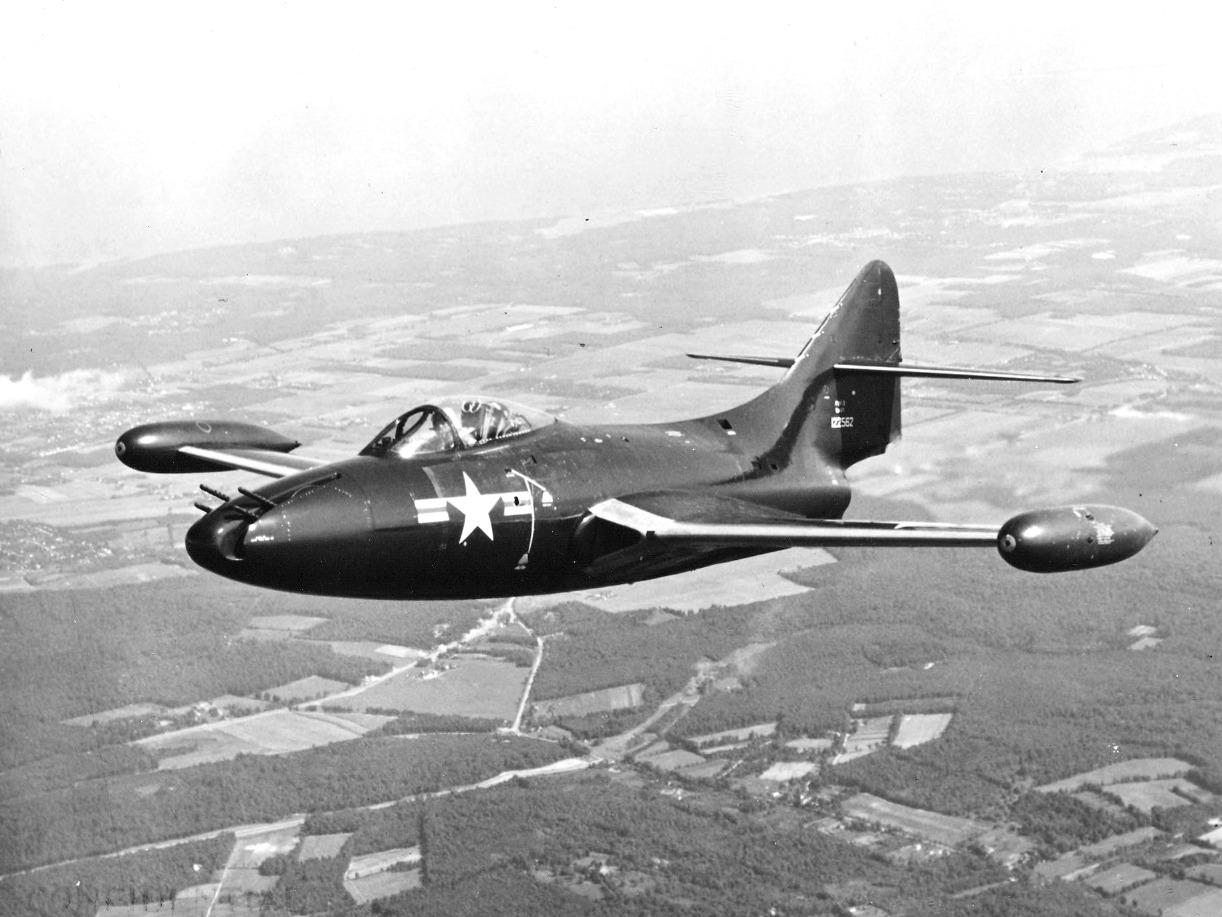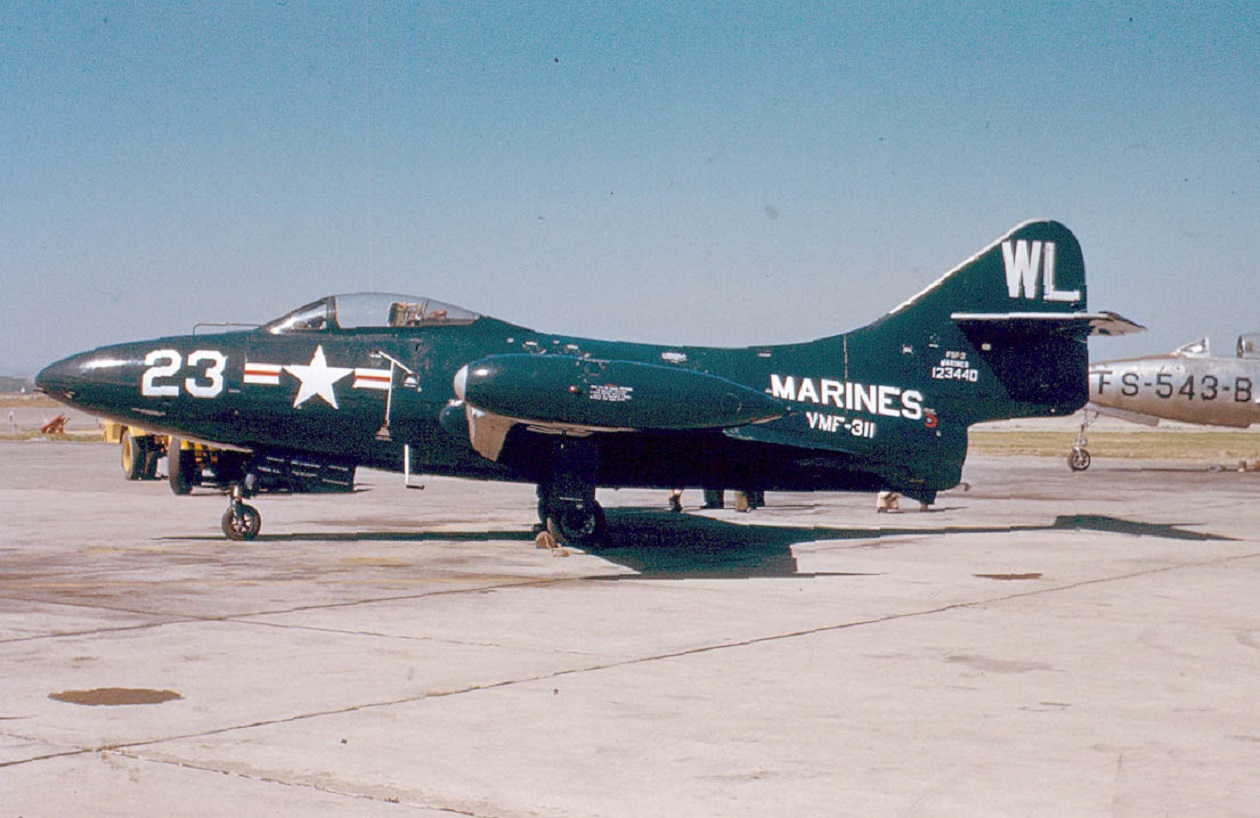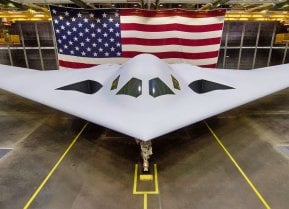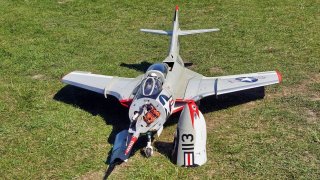F9F Panther: The Real First Jet-to-Jet Killer
A total of 1,382 F9Fs were built - and they made history. The Navy retired the plane in 1958, and the Argentine Navy followed suit in 1969.
F9F Panther, a former U.S. Air Force officer gives us a detailed history: Seventy-plus-years after the fact, the question of who (as in the pilot) and what (as in the plane) scored the first jet-to-jet aerial shootdown in the history of aerial combat remains a matter of some controversy; the only area of agreement is that it happened during the Korean War, sometime in November 1950, and that the victim was a Soviet-designed MiG-15 fighter.
According to the official U.S. Air Force history, the victor was 1st Lt. Russell J. Brown, on November 8, 1950, whist flying a Lockheed F-80 Shooting Star. However, Soviet records – which must of course be taken with the proverbial grain of salt – insist that Brown's victim actually survived the engagement. At least some Western aviation experts believe the Soviets' version of events, amongst them the highly respected Dario Leone of The Aviation Geek Club. Leone insists that the credit actually belongs to U.S. Navy pilot Lt Cdr William T. “Tom” Amen, at the controls of a Grumman F9F Panther, achieved on the day after Lt. Brown's battle. Regardless of who actually achieved this milestone, the Panther's is a history worth examining in greater detail, so without further ado …
Presenting the Panther
Grumman (now known as Northrup Grumman) had already established an enviable reputation with the U.S. Navy fighter pilot community via its pistol-engined propeller-driven fighter planes during WWII, namely the F4F Wildcat and F6F Hellcat, the latter of which was flown by the USN's top-scoring aces of the war and finally obtained air superiority against Imperial Japan's vaunted Mitsubishi Zero. Not content to rest on their laurels, the Grumman executives and R&D wizards won the Navy's design contract in April 1946 (a mere eight months after WWII ended) for the XF9F-1, which was to be a single-seat carrier-based fighter, tasked with the mission of destroying opposing aircraft and proving closer air support (CAS).
The Panther made her maiden flight on November 21, 1947, and officially went operational in September 1949. The straight-winged warbird (yes, mixing my avian and mammalian metaphors here, like I've done so many times in the past; what of it?) boasted a max airspeed of 579 mph (Mach 0.75/ 932 kph/ 503 knots), a cruising speed of 481 mph (Mach 0.62/ 774 kph/ 418 knots), and packed an impressive arsenal to the tune of four 20mm cannons (considerably more powerful than the .50 caliber machine guns on the much more heralded USAF F-86 Sabre). With the specter of the Korean War looming just around the corner, that combo of speed and firepower would soon be put to good use.
Predatory Panthers Pester Pyongyang's Proletarians
Even before the jet-to-jet engagements referenced in the opening of the article, the F9F was already making naval air combat history. On July 3, 1950, barely two weeks after the commencement of hostilities in the so-called "Land of the Morning Calm," Lieutenant (j.g.) Leonard H. "Len" Plog of Fighter Squadron (VF) 51was piloting an F9F-3 when he shot down a North Korean Yakovlev Yak-9 "Frank", thus becoming the first Navy jet pilot to down an enemy plane and earning an Air Medal for his achievement.
As for LCDR Amen's aforementioned MiG-15 kill, at the time he was with VF-111 and escorting a package against the Yalu bridge at Sinuiju. And unlike with Russell Brown, there's no debate as to whether Tom Amen actually scored that kill, as the Russians admitted to this particular loss: they identified the victim as Captain Mijael Grachev of the 139th GvIAP (Guards Fighter Air Regiment). (To any Navy Chaplains reading this article, can I get an "Amen!" and a "Glory Hallelujah!")
Beyond that, the Panther's most impressive exploit of the Korean War was pulled off by LT Royce Williams of VF-781 on 18 November 1952, when, in a single 35-minute encounter, he shot down four MiG-15s. LT Williams's accomplishment is even more amazing when you consider that he was outnumbered seven-to-one and that his F9F sustained 263 — that's right, two hundred and sixty-three(!) — enemy cannon shells and shell fragments. Soviet records acknowledged this defeat as well, listing Captains Belyakov and Vandalov and Lieutenants Pakhomkin and Tarshinov as the Communist pilots KIA'd in the encounter. Unfortunately, as noted by San Diego Union-Tribune reporter Pam Kragen:
"Rather than acknowledge an air battle that might have had the effect of drawing the Soviets into the Korean War, the U.S. Navy and National Security Agency scrubbed the dogfight from its records, and Williams was sworn to secrecy for more than 50 years. As a result, when the nation awarded 146 Medals of Honor to U.S. servicemen for extraordinary valor in the Korean War, Williams didn’t make the list."

San Diego's U.S. Congressional delegation — which includes Republican Rep. Darrell Issa — is attempting to rectify this injustice by preparing an amendment to the 2023 National Defense Authorization Act (NDAA) to include the Medal of Honor for Williams, who is now a retired Captain and 97 years young. In the meantime, Capt Williams was awarded a Medal of Valor at the American Legion Post 416 in Encinitas, California.
Other Naval Aviators who flew the F9F in the skies over Korea included future astronauts John Glenn and Neil Armstrong — perhaps y'all have heard of them?

F9F: Where Are They Now?
A total of 1,382 F9Fs were built. The U.S. Navy retired the plane in 1958, and the Argentine Navy (the only foreign buyer of the warplane) followed suit in 1969. Along the way, the Panther plane served with the Blue Angels and also attained a bit of movie stardom thanks to the film The Bridges at Toko-Ri (based upon James Michener's bestselling novel) starring William Holden, Grace Kelly, Fredric March, and Mickey Rooney. Roughly 23 of them survive today at museums in Argentina and the U.S, including an airworthy specimen at the Cavanaugh Flight Museum in Addison, Texas.
About the Author
Christian D. Orr is a former Air Force officer, Federal law enforcement officer, and private military contractor (with assignments worked in Iraq, the United Arab Emirates, Kosovo, Japan, Germany, and the Pentagon). Chris holds a B.A. in International Relations from the University of Southern California (USC) and an M.A. in Intelligence Studies (concentration in Terrorism Studies) from American Military University (AMU). He has also been published in The Daily Torch and The Journal of Intelligence and Cyber Security. Last but not least, he is a Companion of the Order of the Naval Order of the United States (NOUS).


